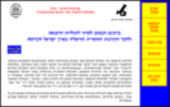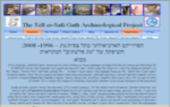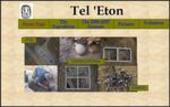Projects and Research Institutes
|
The Ingeborg Rennert Center for Jerusalem Studies was founded in 1995 under the auspices of the Martin (Szusz) Department of Land of Israel Studies and Archaeology in the Faculty of Jewish Studies of Bar-Ilan University. The Rennert Center, directed by Prof. Aren Maeir, deals with the study and research of all aspects relating to Jerusalem from ancient until modern times. Telephone: +972-3-5318299 Email: arenmaeir@gmail.com |
|
|
The History of Medicine in the Land of Israel Antiquity |
The history of medicine in the ancient world has in recent years become one of the most important fields of historical research. In the Department of Land of Israel and Archeology at Bar-Ilan University a numbers of researchers are engaged in research and teaching of the history of medicine in the Land of Israel in ancient times: from the Biblical period, through the age of the Mishna and Talmud, the Middle Ages, and up until modern times. As part of this study, the unit of the History of Medicine in the Land of Israel presents one of the most important centers of research in Israel in this field. The unit carries out extensive activity including: offering academic courses, scientific conventions, designing and holding extension studies for teachers and guides, advising research students, and publishing books and articles. Visit our website at www.biu.ac.il/js/le/hom/index.html |
|
The Tell es-Safi/Gath Archaeological Project
|
Tel Zafit (Tell es-Safi) is a large and commanding tell located in north-eastern Philistia, on the southern bank of the Elah river (south of Kfar Menachem), about half-way between Jerusalem and Ashkelon. One of the largest ancient sites in Israel, it was settled from the Prehistoric periods through Modern times. During the biblical period, this was the location of “Gath of the Philistines” (and earlier, “Gath of the Canaanites”), one of the five cities of the Philistine Pentapolis, well-known from the biblical narratives. For example, Gath was the home of Goliath and Achish, it was to Gath that David escaped from Saul, and it was one of the stations of the wanderings of the ark in Philistia. In fact, Gath was the most prominent Philistine city in the Bible. Later on, during the Crusader period, in the 12th century CE, the fortress Blanche Garde was erected here, as one of the string of forts erected by the Crusaders around Fatimid Ashkelon. |
|
Tel Eton Archaeological Project |
Tel 'Eton is located in the trough valley, on the south-eastern part of the Judean Shephalah, just below the Hebron hills. The site is located in the midst of a large open area, settled by only a few small settlements (moshavim), and where ancient tells and Khirbets, hidden between fields and orchards, dot the landscape. Among the many well-preserved archaeological sites in this area, Tel 'Eton is prominent. The excavations and survey at Tel 'Eton and its surroundings are part of a long-term regional project into the social, political and environmental history of the trough valley (in which the site is located), through a combination of excavations and high-resolution survey. The project was initiated in 2006, and is directed by Prof. Avraham Faust, of the Institute of Archaeology, the Martin (Szusz) department of Land of Israel Studies and Archaeology, at Bar-Ilan University. |
|
Women in Pre- and Post- State Israel  |
Uncovering the hidden and fascinating world of the women in modern Israeli history is a manner in which to learn about society, its characteristics and its history. The Modern Israeli History Unit in the Department of Land of Israel Studies has undertaken the research of the women who have played a major role in defining the modern State of Israel, its culture and society. |








